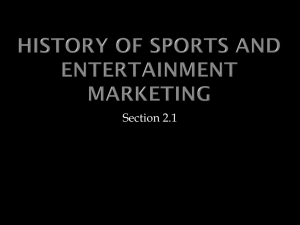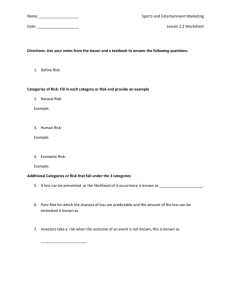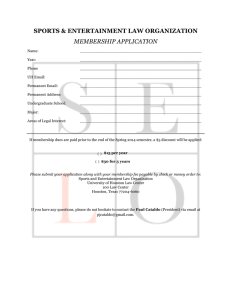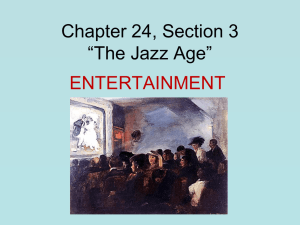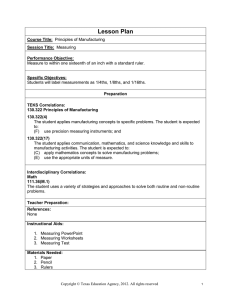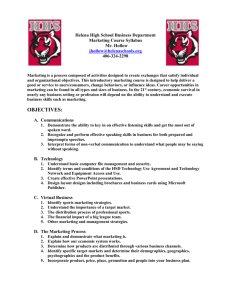Lesson Plan
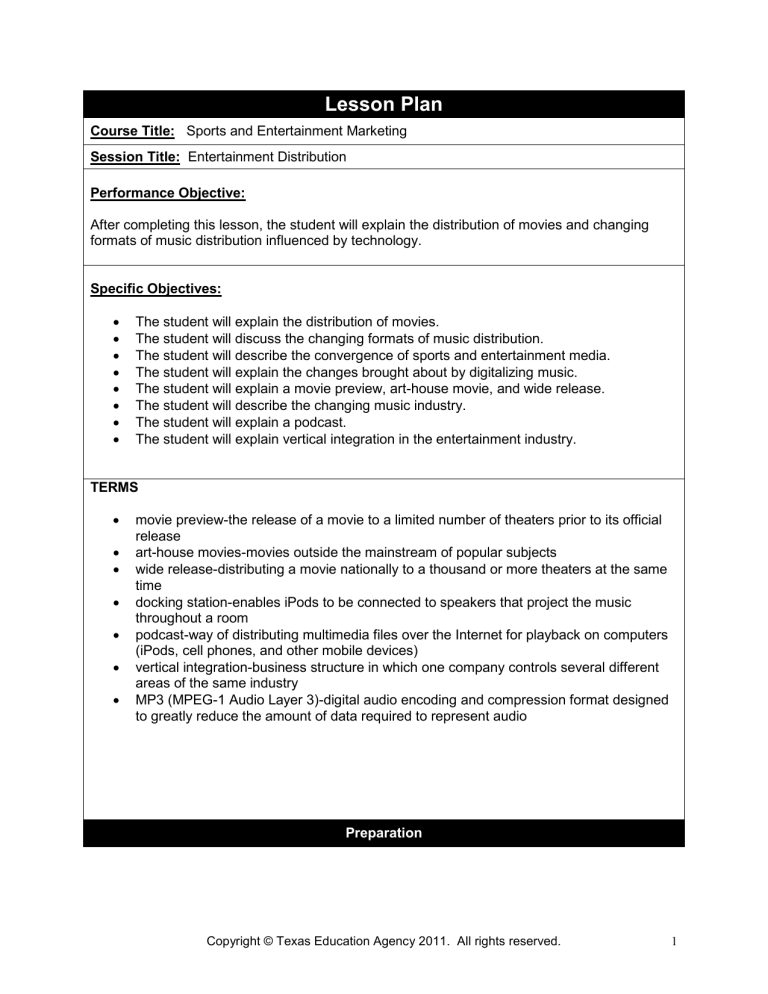
Lesson Plan
Course Title: Sports and Entertainment Marketing
Session Title: Entertainment Distribution
Performance Objective:
After completing this lesson, the student will explain the distribution of movies and changing formats of music distribution influenced by technology.
Specific Objectives:
•
The student will explain the distribution of movies.
•
The student will discuss the changing formats of music distribution.
•
The student will describe the convergence of sports and entertainment media.
•
The student will explain the changes brought about by digitalizing music.
•
The student will explain a movie preview, art-house movie, and wide release.
•
The student will describe the changing music industry.
•
The student will explain a podcast.
•
The student will explain vertical integration in the entertainment industry.
TERMS
•
movie preview-the release of a movie to a limited number of theaters prior to its official release
•
art-house movies-movies outside the mainstream of popular subjects
•
wide release-distributing a movie nationally to a thousand or more theaters at the same time
•
docking station-enables iPods to be connected to speakers that project the music throughout a room
•
podcast-way of distributing multimedia files over the Internet for playback on computers
(iPods, cell phones, and other mobile devices)
•
vertical integration-business structure in which one company controls several different areas of the same industry
•
MP3 (MPEG-1 Audio Layer 3)-digital audio encoding and compression format designed to greatly reduce the amount of data required to represent audio
Preparation
Copyright © Texas Education Agency 2011. All rights reserved.
1
TEKS Correlations:
This lesson, as published, correlates to the following TEKS. Any changes/alterations to the activities may result in the elimination of any or all of the TEKS listed.
130.346 (c)(5)(A)
…explain channels of distribution for sports and entertainment marketing products…
130.346 (c)(5)(B)
…describe activities of each channel member…
130.346 (c)(14)(B)
…distinguish among sports and entertainment marketing terms…
Interdisciplinary Correlations:
English:
110.31 (b)(21)(B)
… organize information gathered from multiple sources to create a variety of graphics and forms
(e.g., notes, learning logs)…
110.31 (b)(22)(B)
…evaluate the relevance of information to the topic and determine the reliability, validity, and accuracy of sources (including Internet sources) by examining their authority and objectivity…
110.31 (b)(23)(C)
… uses graphics and illustrations to help explain concepts where appropriate…
110.31 (b)(23)(D)
… uses a variety of evaluative tools (e.g., self-made rubrics, peer reviews, teacher and expert evaluations) to examine the quality of the research…
Teacher Preparation:
Teacher will review the terms in the outline, PowerPoint slides and handouts to become familiar with lesson.
Teacher should locate and evaluate various resources and websites before the lesson.
Teacher will have assignments and website information ready to distribute to students.
Copyright © Texas Education Agency 2011. All rights reserved.
2
References:
Sports Business Journal
Sports Illustrated
Advertising Age (online magazine)
Instructional Aids:
1. Display for PowerPoint, websites for assignments and class discussion
2. Sports and Entertainment Marketing, 3 rd
edition, Kaser & Oelkers, South-Western
Cengage Learning: Sports and Entertainment Management, Kaser & Brooks, South-
Western Cengage Learning.
3. Advertising Age
4. USA Today
5. Sports Illustrated
Materials Needed:
1. Printer paper
2. Assignments and website information ready to distribute to students.
(Distribution of Music) Direction Sheet
2. Sports Business Journal and Entertainment Industry Economics: A Guide for Financial
Success
3. Internet access to Hulu videos
Student projects will be displayed to increase interest in Sports and Entertainment
Marketing.
Equipment Needed:
1. Computer with PowerPoint and Internet Access
2. Projector to Show Internet Sites Computers for Students to Conduct Research and
Collect Data for Projects
Learner Preparation:
Explain to students how the distribution of music has gone from vinyl records to 8-track tapes, to
CDs, to the latest technology. Then discuss how musicians make money from royalties that they receive for the sale of their music. When individuals download music from the Internet, the artist
(musician) may not earn the royalties that they deserve. This industry trend has an impact on prices charged at concerts and restrictions of the distribution of music.
Introduction
Copyright © Texas Education Agency 2011. All rights reserved.
3
Introduction (LSI Quadrant I):
SHOW: Show students a vinyl record, 8-track tape, CD, and iPod. Then explain how the distribution of music has evolved.
ASK: Ask students to explain how popular musicians earn a living.
SAY: Explain how musicians count on royalties from the sale of their music.
ASK: Ask students to raise their hand if they have downloaded music from the Internet.
SAY: Explain how illegal downloading of music has cut into the profits of musicians.
ASK: Ask students how they learn about the latest movies. Ask students if they go to the theater or watch movies through a different distribution channel.
SAY: Explain how movies are now cutting costs through the location of production and the types of distribution.
ASK: Ask students why more people are choosing to stay home to watch movies and sporting events.
SAY: Explain how the cost of attending the live event is more than consumers can afford. Also, individuals like the security of their homes.
Outline
Outline (LSI Quadrant II):
Instructors can use the PowerPoint presentation, slides, handouts, and note pages in conjunction with the following outline.
MI Outline Notes to Instructor
I. Entertainment Distribution
A. Movies
1. the Big Screen
2. movie preview-release of a movie to a limited number of theaters prior to its official release
4. art-house movies-movies outside the mainstream of popular subjects
(independent film makers)
5. wide release-distributing a movie nationally to a thousand or more theaters at the same time
Use PowerPoint and current events as aids.
Movie producers and television broadcasting have been challenged to keep up with the latest consumer trends.
Consumers may decide not to spend
Copyright © Texas Education Agency 2011. All rights reserved.
4
B. Watch it at Home
1. Cable (HBO)
2. DVDs
3. Netflix
II. Making Music
A. from vinyl to 8-track to CD to iPod, etc.
B. docking station-enables iPods to be connected to speakers that can project the music throughout a room and not just the individual’s earbuds of the iPod
C. Graceland and other theme parks (Dolly wood) honor legends of music
III. Technology and Distribution Media
A. Media Merge
B. cable television and satellite dish
C. podcast-way of distributing multimedia files over the Internet for playback on computers, iPods, cell phones and other mobile devices
D. Digital (HDTV)
E. Space-Based Radio (satellite radio)
1. provides what subscribers want to hear, when and wherever they want to hear it
2. over 100 channels offer a wide range of music and news, sports, talk, variety, and large sums of money at the movie theater and opt to rent movies or watch them online from companies like
Netflix.
The wide release is used to promote projected popular movies in 1,000 or more theaters at the same time.
Use PowerPoint as aid.
Vinyl records were popular in the 60s, 8track tapes in the 70s, and CDs in the 80s.
Now iPods, MP3
Players, and downloaded music are used to obtain popular music.
Use PowerPoint as aid.
Podcasts allow individuals to see television in a variety of formats.
Copyright © Texas Education Agency 2011. All rights reserved.
5
comedy shows
F. Mega Distribution
1. broadcast webs-groups/affiliations of television networks, production studios, and related entertainment businesses that produce shows or provide services for other members in the group
2. vertical integration-one company controls several different areas of the same industry
a. Walt Disney Corporation
b. first-motion picture production
c. now-movie studios, record labels, theatrical production companies, animation studios, television networks, theme parks and resorts
IV. Digital Platforms
A. major music distributors-EMI, Universal,
Warner, Sony/BMG
B. Reduced Music Sales
1. file sharing-making files available for others to download
2. piracy-unauthorized copying of music
C. Internet Music Revolution
1. $13.3 billion a year music industry took a strong stand and filed lawsuits against illegal online music swappers
2. Recording Industry Association of America
(RIAA) uses software to trace the unique identification number that identifies a computer online
3. when RIAA finds a user with a large collection of copyright-protected illegally obtained music, a subpoena can be issued and a lawsuit filed against the computer user
4. Apple and iTunes-customers can legally purchase downloaded songs for 99 cents each
5. MP3 (MPEG-1 Audio Layer 3)-a digital audio encoding and compression format designed to greatly reduce the amount of data required to represent audio (download music into small digital files)
Companies like Disney have become heavily involved in the entertainment industry.
Controlling a larger segment of the entertainment industry involves risk and reward.
Use PowerPoint as aid.
The music production companies were aware that some consumers were taking unfair advantage of the latest technology by illegally downloading music from the Internet. The music production industry took action against individuals who were stealing music.
Apple took advantage of the trend with iTunes that allowed customers to download songs for 99 cents each.
The MP3 player allows consumers to store thousands of their favorite songs on a small device. The MP3 player and other
Copyright © Texas Education Agency 2011. All rights reserved.
6
similar devices are popular items for individuals who are waiting at airports and customers on the airplanes during flight.
Verbal
Linguistic
Logical
Mathematical
Visual
Spatial
Musical
Rhythmic
Bodily
Kinesthetic
Intra- personal
Inter- personal
Naturalist Existentialist
Application
Guided Practice (LSI Quadrant III):
Ask students to use the Internet to look up the latest distribution of music. Each student must list at least five trends for the music industry. Then ask students to describe the latest technology they have used to obtain and listen to their favorite music. Students will share their ideas in a productive class discussion.
Independent Practice (LSI Quadrant III):
Distribution of Music Project
1. Ask students to use the Internet to learn the history about a popular musician or musical group. Then ask students to conduct research about the distribution of their music.
2. Ask students to prepare a report about their selected musician or group. The report should include information about the type of music, concerts performed, and sales generated from the music.
3. Ask students to prepare a professional PowerPoint presentation about the selected musician or group. The PowerPoint presentation should include information about the latest distribution of music and strategies to protect performers’ profits from sale of their music. The PowerPoint presentation should include a sample of the music for the selected musician or group.
4. Ask students to design a T-shirt for the musician or group. The shirt will be sold at concerts and online.
5. Ask students to design a professional poster or flyer that advertises the musician or group. This document must include the WHO, WHAT, WHEN, WHERE, PRICE and
WHERE TICKETS CAN BE PURCHASED.
This project will be evaluated using the assigned rubric.
Copyright © Texas Education Agency 2011. All rights reserved.
7
Summary
Review (LSI Quadrants I and IV):
Question: Why is it a good idea to locate movie theaters close to shopping malls and restaurants?
Question: What is the purpose of a movie preview?
Question: What is a wide release?
Question: What is a movie trailer?
Question: What are three ways that movies are distributed?
Question: What is an iPod?
Question: What is a docking station?
Question: What changes in music distribution did portable digital music players bring?
Question: What is a podcast?
Question: What are two advantages of satellite radio?
Question: Why did the Recording Industry Association of America (RIAA) take legal action against individuals downloading music from the Internet?
Evaluation
Informal Assessment (LSI Quadrant III):
Instructor should observe the work ethic of individuals involved in class discussions and the independent practice activity.
Formal Assessment (LSI Quadrant III, IV):
Students will be evaluated on their “Distribution of Music Project” by using the assigned rubric.
Extension
Copyright © Texas Education Agency 2011. All rights reserved.
8
Extension/Enrichment (LSI Quadrant IV):
Music Media Preference for Different Generations Project
Student Directions
Conduct research on the preferred music media for individuals in your age group, your parents’ age group, and your grandparents’ age group. Explain what type of media is used by each group to listen to their favorite music and how you would promote the newer media to the older age groups. Why might the older age groups resist the latest musical technology? Report your findings in a one-page typed report.
This project will be evaluated using the associated rubric.
Copyright © Texas Education Agency 2011. All rights reserved.
9
Sports and Entertainment Marketing
15 Student Directions
Independent Practice (LSI Quadrant III):
Distribution of Music Project
1. Use the Internet to learn the history about a popular musician or musical group. Then ask students to conduct research about the distribution of their music.
2. Prepare a report about their selected musician or group. The report should include information about the type of music, concerts performed, and sales generated from the music.
3. Prepare a professional PowerPoint presentation about the selected musician or group.
The PowerPoint presentation should include information about the latest distribution of music and strategies to protect performers’ profits from sale of their music. The
PowerPoint presentation should include a sample of the music for the selected musician or group.
4. Design a T-shirt for the musician or group. The shirt will be sold at concerts and online.
5. Design a professional poster or flyer that advertises the musician or group. This document must include the WHO, WHAT, WHEN, WHERE, PRICE and WHERE
TICKETS CAN BE PURCHASED.
This project will be evaluated using the assigned rubric.
Copyright © Texas Education Agency 2011. All rights reserved.
10
Independent Practice (LSI Quadrant III)
Distribution of Music Rubric
CATEGORY 20 15
Presentation
PPT
10 5
Well-rehearsed with smooth delivery that holds audience attention.
Rehearsed with fairly Delivery not smooth, smooth delivery that holds audience attention most of the time. but able to maintain audience attention most of the time.
Delivery not smooth and audience attention often lost.
Attractiveness
PPT
Content
PPT
Report
Makes excellent use of font, color, graphics, effects, etc. to enhance the presentation.
Makes good use of font, color, graphics, effects, etc. to enhance the presentation.
Makes use of font, color, graphics, effects, etc. but occasionally these distract from the presentation content.
Covers topic indepth with details and examples.
Subject knowledge is excellent.
Includes essential knowledge about the topic. Subject knowledge appears to be good.
Includes essential information about the topic but there are 1-2 factual errors.
Use of font, color, graphics, effects etc. but often these distract from the presentation content.
Content is minimal
OR there are several factual errors.
Organization
Report
PPT
Content is well organized using headings or bulleted lists to group related material.
Uses headings or bulleted lists, but the overall organization of topics appears flawed.
Content is logically organized for the most part.
There was no clear or logical organizational structure; just lots of facts.
Originality
PPT
Poster
T-shirt
Product shows a large amount of original thought.
Ideas are creative and inventive.
Product shows some Uses other people's original thought.
Work shows new ideas and insights. ideas (giving them credit), but there is little evidence of original thinking.
Uses other people's ideas, but does not give them credit.
Total Points Earned ________
Copyright © Texas Education Agency 2011. All rights reserved.
11
Extension/Enrichment (LSI Quadrant IV)
Music Media Preference for Different Generations Project
CATEGORY 20 15 10
Amount of
Information
All topics are addressed and all questions answered with at least 2 sentences about each.
5
All topics are addressed and most questions answered with at least 2 sentences about each.
All topics are One or more topics addressed, and most questions answered were not addressed. with 1 sentence about each.
Quality of
Information
Information clearly relates to the main topic. It includes several supporting details and/or examples.
Information clearly relates to the main topic. It provides 1-2 supporting details and/or examples.
Information clearly relates to the main topic. No details and/or examples are given.
Information has little or nothing to do with the main topic.
Organization Information is very organized with wellconstructed paragraphs and subheadings.
Information is organized with wellconstructed paragraphs.
Information is organized, but paragraphs are not well-constructed.
The information appears to be disorganized.
Paragraph
Construction
All paragraphs include introductory sentence, explanations or
Most paragraphs include introductory sentence, explanations or details, and details, and concluding sentence. concluding sentence.
Paragraphs included related information
Paragraphing structure was not but were typically not constructed well. clear and sentences were not typically related within the paragraphs.
Mechanics No grammatical, spelling, or punctuation errors.
Almost no grammatical, spelling, or punctuation errors.
A few grammatical, spelling, or punctuation errors.
Many grammatical, spelling, or punctuation errors.
Points Earned ________
Copyright © Texas Education Agency 2011. All rights reserved.
12
